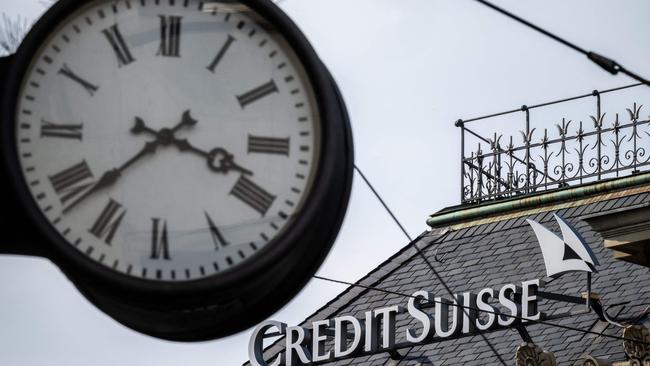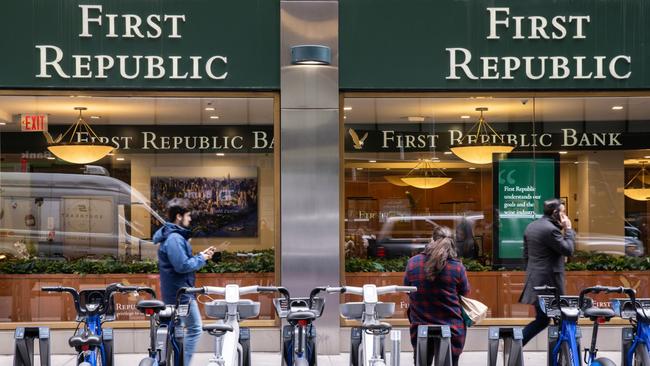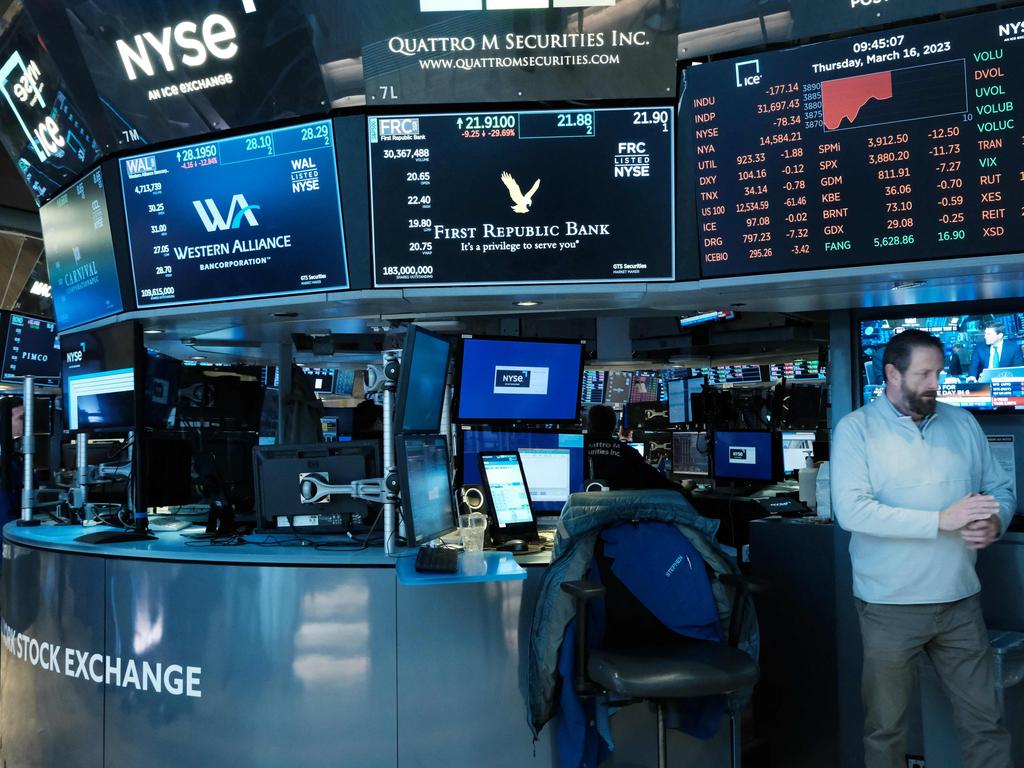
The world banking community is a safer place but the takeover ushers in a different global and Australian environment.
The stance of UBS and the Swiss central bank – The Swiss National Bank – was forced on them because as, I pointed out over the weekend, US and European sharemarkets had started to realise that last week’s two high-profile bank rescue efforts – First Republic and Credit Suisse – were faltering.
The UBS takeover will not change the US situation and even in Europe there will remain underlying nervousness.
Those dramas accelerated the flow of money into US bonds, money market funds, Bitcoin and gold. Australian and global interest rates rises look set to be curtailed but many world banks face lower margins – hence the fall in bank shares whose survival is not in danger.
The UBS takeover may have avoided a crisis but we face a world with a lower growth outlook not unlike what Japan has experienced.
For Australia the likely repercussions of the long-term interest rate outlook has been sudden and dramatic.
Westpac veteran economist Bill Evans revised his interest rate rise forecasts to come into line with the Commonwealth Banks Gareth Aird in predicting that there is now only one 0.25 per cent interest rate rise to come – allowing the official rates to peak at 3.85 per cent rather than the 4 per cent plus forecasts that had earlier dominated market predictions.
Evans thinks the Reserve Bank will delay the “scheduled” April increase until May.
Australia and the US both suffer structural inflation which might persist but the big fall in oil prices and in some areas of agriculture give hope that inflation can be contained, given the bank crisis may restrict credit and confidence – exactly what much higher interest rates are designed to do.
The threatened unravelling of the two bank rescue efforts underlined how quickly confidence can be eroded. The dramas the rescues generated are different but related.
Whereas Silicon Valley Bank’s deep troubles arose because it invested its deposits in low-yielding US bonds which slumped in value as interest rates rose, First Republic’s problem is that its portfolio is dominated by low fixed-interest rate long-term home loans. Unlike Australian fixed interest rate loans for housing, in the US the fixed rate loans can be as long as 30 years.
These are illiquid assets that in the case of First Republic were being financed by short-term deposits.
First Republic has been losing deposits to the big banks and so last week’s scheme seemed an elegant rescue. The cream of the America’s big banks led by Bank of America, Citigroup, Wells Fargo, Goldman Sachs, Morgan Stanley, Bank of New York Mellon, PNC Bank and State Street would respond by depositing money with First Republic.
These are huge banks and the total package they came up with, at $US30bn ($44.8bn), was little more than petty cash given their combined size. And it wasn’t enough.
First Republic was forced to ask the American Federal Home Loan Banks (FHLB) body for extra funds. Loans from this body rank above all deposits and other claims and in the past the ranks of those who have called on this body have had a high failure rates. First Republic’s call follows a similar call from Silicon Valley Bank.

No one knows just how much money is currently being loaned from this effective backer of last resort to troubled US banks but the FHLB has substantially increased its issues of gilt aged bonds, which would indicate that it is either pumping or expects to pump large sums into “rescuing” not just First Republic but other banks.
And so the big US banks were being asked to deposit money with First Republic, that ranks after the FHLB which was also spraying money around other banks. That’s one reason why the amount was restricted to $US30bn.
I do not know the outcome of these US dramas but historically when confidence has been shattered small US banks go under or are taken over but big ones are saved. Lehman was an exception in 2008 and its collapse triggered the global financial crisis.
Because Credit Suisse is a major global bank the fate of the Swiss central bank rescue package had wider global ramifications.
The trouble with Credit Suisse is that nobody really knows the depth of its problems. Its constant denials that there are problems compound the uncertainty because the market does not believe the Credit Suisse board.
There were fears about its involvement with the Indian entrepreneur Sanjeev Gupta but again details are sparse. Perhaps there are other similar exposures in the Credit Suisse portfolio that have yet to be revealed.
Credit Suisse appealed to the Swiss National Bank for help because large global banks were becoming increasingly unwilling to deal with Credit Suisse. And underlining this looming crisis the value of Credit Suisse bonds slumped
The Swiss central bank put up $US54bn in extra loans and Credit Suisse spent about 5 per cent of the money raised to support its bonds, but it wasn’t enough. Once it was revealed that the global banks who were cutting back their exposure to Credit Suisse securities included majors like Society Generale, Deutsche Bank and HSBC, the sharemarket realised that much more was required.
The Swiss central bank called on the other major Swiss bank, UBS — to help so as to keep the Swiss banking sector intact.
This should have happened much earlier but UBS is reluctant, given the unknown quantity of Credit Suisse exposures. And Credit Suisse does not want to virtually give away its banking enterprise which it claims is sound.
It had no choice because you can’t run a bank without confidence
The danger was that the banking crisis would become like a bushfire where “ember attacks” start new fires that have even greater intensity.
In this environment major interest rate rises seem unthinkable so US 10-year bond yields are falling and we may be headed into a period of low global growth, higher inflation than central banks are currently targeting, and longer-term higher than past interest rates. But that’s simply a prediction. There is a lot more action on the ground to come.
But that global view has a caveat.
There is just a chance — no certainty— that Chinese President Xi Jinping will force Russian President Vladimir Putin into a meaningful peace offering.







Despite the rhetoric the Union Bank of Switzerland — now called UBS – obeyed the instructions of the Swiss central bank and will acquire Credit Suisse.